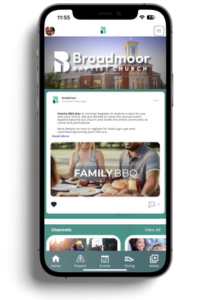Creating a great Check-In experience for guests and families is key to a smooth and welcoming Sunday morning. TouchPoint’s Recommended Involvements feature, part of its intelligent Load Balancing tool, is designed to do just that—simplify classroom assignment while reducing stress for Check-In volunteers.
This TouchPointer highlights how churches can streamline operations by combining manned Check-In stations for guests with self Check-In kiosks for regulars. This setup helps get everyone to their classrooms quickly while still maintaining a friendly, helpful environment for new visitors.
The Recommended Involvements feature intelligently suggests classes based on one of two settings:
- Capacity-Based: Fills one classroom at a time, moving to the next when the current one is full.
- Least Attending: Evenly distributes check-ins by showing the class with the fewest attendees first.
This ensures classroom sizes remain balanced and manageable while helping volunteers avoid guesswork.
What Recommended Involvements Support:
- Smart Classroom Suggestions For Efficient Check-Ins
- Balances Room Sizes Automatically In Real Time
- Reduces Decision-Making For Volunteers
- Enhances Guest Experience At Manned Stations
And remember—high-traffic guest areas are best handled by experienced volunteers. First-time volunteers are better placed in supporting roles where the pace is lighter and guidance is more structured.
Looking For More Information On Check-In?
To explore more best practices for managing Check-In and safety with TouchPoint, be sure to:
- Need personalized support? Contact our Consulting Team at [email protected]
- Related Articles: Church Check-In: Essential Strategies for Security, Efficiency, and Growth
- Resources: TouchPoint Software Documentation
- Training Videos: TouchPoint Software Training Library
When Broadmoor Baptist Church in Mississippi made the decision to transition away from their aging church management system, they weren’t just looking for better software—they were searching for a ministry tool that could support their growing congregation, improve data accuracy, and enhance the Sunday experience for everyone from first-time guests to seasoned members. What they found in TouchPoint was more than a platform. It was a strategic partner that empowered their vision to know and be known.
The Road To Implementation
Broadmoor is no small church. With over 5,000 members and roughly 2,000 in weekly worship attendance, the church needed a system robust enough to handle complexity while flexible enough to meet ministry-specific needs. Kathy Morgan, who brought years of software experience into her role at Broadmoor, knew from day one that their current solution wouldn’t support long-term ministry goals.
After attending TouchPoint Summit in Chicago in 2023 and evaluating other vendors, the team at Broadmoor unanimously agreed—TouchPoint wasn’t just the best option, it was the right one.

Laying The Foundation: A Culture Of Data And Ministry
One of the first major initiatives following implementation was to fully integrate TouchPoint’s Check-In functionality. But this wasn’t just about printing name tags. For Broadmoor, checking in was about reshaping the way their church family connected—with staff, with each other, and with ministry opportunities.
Michael Bowen, who oversees communications and is part of the church’s creative arts ministry, explained that building a culture of checking in started with casting vision.
“At the end of the day, it’s about ministry. Yes, it’s just a database. Yes, it’s just a tool. But if the data is accurate, it helps us make better decisions.”
The team approached implementation with intentionality: instead of training staff on a generic sandbox, they trained using real Broadmoor data. Real people, real groups, real processes. This made adoption easier and gave staff confidence that the system would support—not complicate—their workflows.
Creating A Culture Shift

The heart of Broadmoor’s Check-In success lies in its cultural transformation. Historically, Check-In was limited to next-gen ministries for security tags. But with TouchPoint, Broadmoor began encouraging every attendee to check in, regardless of age or ministry involvement.
Check-In kiosks were strategically placed at main entrances and ministry areas, and the team prioritized ease of use and reliability. They opted to hardwire all stations to prevent the risk of Wi-Fi disruptions.
In just four weeks, Broadmoor saw nearly 70% of worship attendees checking in—a staggering achievement for a church that hadn’t emphasized Check-In in over a decade. That number recently rose to 72%.

The TouchPoint Team: Personal Touch Meets Strategic Support
To reinforce checking in, Broadmoor created a “TouchPoint Team” of volunteers and staff who manned kiosks each Sunday. These team members served a dual role: helping people navigate Check-In while also capturing feedback for ongoing improvement.
As Kathy noted, even less tech-savvy members found the new system easier than the previous one—and that’s no small win.
Staff were expected to serve during key windows, which not only provided Sunday morning support but also kept leadership engaged in the process. That visibility reinforced the church’s commitment to making checking in a part of their culture, not just a task.
And for guests who weren’t in the system? They got added into the database! As Kathy described, one man who had intentionally stayed under the radar for years finally asked for a name tag. “To catch you, I need your phone number,” Kathy told him. That simple interaction showed how Check-In was bridging the gap between anonymity and belonging.
Staff Engagement And Training
What made Broadmoor’s implementation so successful wasn’t just infrastructure—it was the engagement of the entire staff. Kathy sent out a daily “My TouchPoint Tip of the Day,” helping staff learn the platform in bite-sized, approachable ways. From updating profiles to searching birthdays, each tip was designed to make TouchPoint approachable and practical.
To cap off training, the team organized a TouchPoint scavenger hunt—a creative, interactive way to get staff exploring the system and learning by doing.
And the results speak for themselves. More than 380 members have already updated their profiles, including photos and contact information. Members are not just passively existing in the database—they’re actively participating in its accuracy.
Moving Forward: Next Steps

Broadmoor is already thinking ahead. Their team is exploring more efficient ways to process first-time guests, especially those who may not make it to the welcome desk. iPads with simplified forms may soon be deployed to help volunteers input guest info more quickly.
Broadmoor’s Church Branded Mobile App is also on the horizon. While it’s not live yet, the team is using this time to build anticipation and keep the momentum going. Once released, the app will add another layer of convenience, allowing families to Pre Check-In from their phones and streamline their Sunday mornings even further.
The Strategic Value Of Check-In
For Broadmoor, Check-In isn’t about tracking attendance. It’s about intentional ministry. It’s about making sure no one falls through the cracks. It’s about stewarding the people God brings through their doors.
As Michael put it, “Churches have historically made decisions based on anecdotal evidence. TouchPoint helps us be more strategic. But we had to set it up to win—it doesn’t do the work for you.”
Broadmoor Baptist’s journey with TouchPoint is a compelling example of how the right tools, paired with the right vision, can lead to cultural transformation. Their story reminds us that software isn’t just a system—it’s a ministry partner when deployed with purpose.
Managing member access to your facility shouldn’t be a hassle—and with TouchPoint’s Building Check-In, it isn’t.
In this TouchPointer, Hayley introduces a simple yet powerful way to manage building access using Building Check-In. Designed primarily for locations like gyms, activity centers, and community spaces, this feature ensures quick and seamless entry while providing real-time visibility for attendants.
When members arrive, they can easily enter all or part of their phone number at the kiosk, select the activities they’re attending, and proceed inside. While the system logs previous check-ins, it’s important to note that Building Check-In is not designed for attendance tracking—its main goal is to facilitate smooth entry and access.
From streamlined access to real-time staff monitoring, TouchPoint’s Building Check-In delivers a smart, efficient way to manage foot traffic while keeping your community connected.
Key Benefits:
- Simple kiosk-based access for members
- Real-time activity monitoring for staff
- Effortless integration into gyms and other shared spaces
Looking For More Information On TouchPoint’s Check-In Suite?
Explore more best practices for managing Check-In and enhancing security with TouchPoint:
- Related Articles: Church Check-In: Essential Strategies for Security, Efficiency, and Growth
- Resources: TouchPoint Software Documentation
- Training Videos: TouchPoint Software Training Library
- Need personalized support? Contact our Consulting Team at [email protected]
Here’s how you can implement a Profile Ring when you’ve identified a security concern related to a person in your database at Check-In:
Step 1: Remove The Phone Number From Their Record
This step is key. In order to prevent the person from checking in through self-service stations, you’ll need to remove the phone number from their profile. If they’re part of a household, be sure to remove the phone number from all other associated records in that household as well.
**Important: This is the ONLY situation where we recommend removing data from TouchPoint.
Step 2: Add A Profile Ring Or Status Flag
With the phone numbers removed, the person will now have to check in at a manned Check-In station, where a staff member can search for their name manually. When their profile appears, the staff member will see the colored Profile Ring—a visual indicator that signals a need for special attention.
Choose a ring color that your team has designated for security-related flags. Make sure your Check-In volunteers and staff are trained on what different colors mean and how to respond appropriately.
Step 3: Document And Train Your Team
This process only works when everyone is on the same page. Train your Check-In team to:
- Know which colors correspond to which flags
- Understand how to search for a name manually
- Take the appropriate steps when a Profile Rdesdswing is present
Also, be sure to document this protocol so it’s part of your internal safety procedures.
Why This Approach Matters
This workflow not only ensures greater safety at Check-In but also respects the privacy of the individual. It prevents the person from slipping through self Check-In unnoticed while empowering your staff with the tools to act with discretion and care.
While situations that require this process may be rare, it’s important to be prepared. The Profile Ring feature offers an effective way to support your church’s security protocols—keeping your community safe and your systems consistent.
If your church hasn’t set up a protocol for using Profile Rings, now’s the time to start.
Looking For More Information On Check-In?
To explore more best practices for managing Check-In and safety with TouchPoint, be sure to:
- Need personalized support? Contact our Consulting Team at [email protected]
- Related Articles: Church Check-In: Essential Strategies for Security, Efficiency, and Growth
- Resources: TouchPoint Software Documentation
- Training Videos: TouchPoint Software Training Library
We’re excited to share that Mobile App Version 3.8 has officially been released! As part of our rollout process, the update first appeared in the Beta channel, accessible through TestFlight (iOS) or the Android beta channel.
What Churches Need To Know
Now that the update has been released in beta, it’s crucial for churches to take a moment to review their app before going fully live. This includes checking:
- Colors
- Logos
- Any branding elements
If any changes are needed, it’s far easier to catch and address them during the beta stage. Once an app is live, making corrections may take up to a week or longer due to App Store review processes.
For Churches Still In Beta
If your church is still in the beta phase:
- You’ll receive the update automatically.
- No action is needed beyond continuing your normal beta testing process.
- If you’ve been waiting for this release to go live, please contact your consultant to move forward.
For Churches With Live Apps
Once your church has reviewed and approved the new version, you have a few options:
- Request To Go Live Immediately:
- We’ll submit your app for production.
- Apple requires a review process, so while we’ll move quickly, approval can take a few days or more.
- Schedule A Future Go-Live Date:
- We can submit the app now but delay the launch until a date you specify.
- Note: It still needs to pass Apple’s review before that date.
- Opt Out Of Production Submission for Now:
- If you need to make adjustments or plan to change something that requires a new build, we’ll hold off.
Important Reminder
If we don’t hear from you within 10 days, we will begin submitting the beta version for production review automatically.
If you have any questions or need assistance with the update process, we’re here to help! Please reach out to our team at [email protected].
Volunteers are essential to every ministry, but keeping them engaged, equipped, and excited can be challenging. That’s why we hosted March’s webinar, which focused on the full volunteer journey, from initial interest to long-term involvement. Matt and Hayley of the TouchPoint Marketing team walked through a seven-step process that churches can use to build a healthy, discipleship-driven volunteer culture.
If you missed the live session (or want to revisit the ideas we shared), we’ve got you covered with a replay and a quick recap below.
Here’s What We Covered:
1. Start With Awareness
You can’t grow your volunteer base if people don’t know where help is needed. We discussed practical ways to get the word out—announcements, signage, emails, and more. TouchPoint’s Search Builder also helps you identify members who’ve never served and might be ready to start.
2. Capture And Organize Interest
Once someone raises their hand to help, the goal is to respond clearly and quickly. We showed how to use TouchPoint Registrations to capture serving preferences and availability—plus how to guide next steps using Process Builder.
3. Onboarding Done Right
From background checks to shadowing and spiritual gifts assessments, onboarding should be thorough—but not overwhelming. With our integrated tools, you can track every step and make sure no one slips through the cracks.
4. Keep Communication Flowing
Clear communication helps volunteers feel valued and informed. With features like Scheduler, profile rings, and the TouchPoint Mobile App, you can send reminders, check in regularly, and ensure everyone’s on the same page.
5. Provide Opportunities To Grow
Volunteers want to feel like they’re growing, not just filling a spot. We talked about creating leadership pathways, offering refresher training, and encouraging volunteers to explore new roles when they’re ready.
6. Celebrate The Wins
Don’t underestimate the power of a thank you. Whether it’s a handwritten note, a free cup of coffee, or a shoutout on social media, showing appreciation goes a long way in creating a culture where volunteers feel seen.
7. Check-In And Re-Evaluate
Seasons change, and so do people’s capacity to serve. Build regular check-ins into your volunteer process to help avoid burnout and to support your team’s long-term health and involvement.
Bonus: Preventing Volunteer Burnout
We wrapped things up with real talk about rest—how to schedule intentional time off, spot signs of fatigue, and make sure volunteers feel supported, not just needed.
Watch The Full Replay
Catch the full webinar replay below:
Want More Tips On Volunteer Management?
Strong volunteer coordination is key to building and maintaining a healthy volunteer culture. Discover practical tips for recruiting, scheduling, and engaging volunteers to ensure your church is ready to welcome guests and serve well.
Whether you’re leading a team of two or two hundred, we hope these strategies help you build a volunteer culture that’s organized, sustainable, and rooted in discipleship.
Additional resources you may enjoy: The Ultimate Guide To Volunteer Coordination
Stay tuned for more webinars!
In today’s church environment, ensuring the safety and security of children during ministry activities is paramount. Implementing an effective Check-In system not only safeguards children but also fosters trust among parents and streamlines administrative processes.
This comprehensive guide explores strategies for utilizing a church Check-In system, emphasizing children’s ministry while highlighting additional applications across various church events. While many church management softwares have the standard features and functionality that may seem commonplace, we’ve decided to include those “basic” principles and add an “elevated” idea or experience to implement as well.
1. Facilitating A Welcoming Environment For New Families
A well-implemented Check-In system serves as a vital connection point for newcomers:
Basic
Efficient Registration Process: Streamlined Check-In procedures make it easier for new families to register their children, reducing wait times and creating a positive first impression.
Elevated
Customizable Labels and Branding: Personalized name tags with the church’s branding can make new attendees feel welcomed and part of the community from the outset.
2. Enhancing Security In Children’s Ministry
A strong church Check-In system serves as the first line of defense in protecting children under the church’s care. Key components include:

Basic
Secure Tags for Pickup: Upon Check-In, each child receives a unique identification tag, and parents or guardians are provided with a corresponding tag. This matching system ensures that only authorized individuals can retrieve the child, significantly reducing the risk of unauthorized pickups.
Elevated
Check-Out Procedures: Implementing a check-out process allows the church to document when a child leaves the premises and with whom. This dual-record system provides a clear timeline of the child’s stay, enhancing accountability and security.
3. Streamlining Attendance And Data Management
Beyond security, Check-In systems offer valuable insights into attendance patterns and aid in efficient data management:
Basic
Automated Attendance Tracking: Digital Check-In systems automatically record attendance, minimizing manual errors and providing real-time data. This information is crucial for understanding participation trends and planning future events.
Elevated
Bi-Directional Communication: Two-way communication between your church Check-In system and your classrooms allows for a safe, secure, and personalized experience for your families. Utilizing a Check-In dashboard ensures that teachers and volunteers can see at a glance who is in their classroom and who is on their way. It also allows for immediate access to pertinent information, such as emergency contacts and medical alerts.
4. Expanding Check-In Systems Beyond Children’s Ministry
While primarily utilized for children’s ministry, you can disable secure tags or labels for other events. Check-In systems can be adapted and leveraged in other ways:

Basic
Volunteer Coordination: Implementing Check-In for volunteers helps monitor service hours, manage assignments, and recognize contributions, fostering a culture of appreciation and accountability.
Elevated
Event Management: For events like retreats, workshops, or community gatherings, Check-In systems can register attendees, print name tags, and track participation, ensuring organized and efficient operations. When the Check-In system records attendance, you now have a list of attendees you can communicate with in future follow-ups.
5. Leveraging Pre-Check And Mobile Features
Modern Check-In systems offer advanced features that enhance user experience:
Basic
Pre-Check-In Options: Allowing families to check in before arriving at the church via a mobile app reduces congestion at Check-In stations and provides a seamless experience.
Elevated
Mobile Integration: Mobile-enabled Check-In allows parents to use their smartphones for the process, offering convenience and aligning with contemporary digital habits.
6. Enhancing Safety Measures Against Potential Threats
A comprehensive Check-In system contributes to the overall safety of the church environment:

Basic
Restricted Access: Utilizing the Check-In system to control access to children’s areas and information ensures that only authorized personnel and parents can enter, preventing unauthorized individuals from gaining access. Maintaining a culture of safety by locking the manned station whenever it’s unattended is vital to protecting your church’s information.
Elevated
Background Checks: Integrating background checks for volunteers and staff into the Check-In system ensures that individuals working with children have been properly vetted, mitigating potential risks. When a volunteer checks in, have an easily identifiable way to show that a volunteer is up to date on their background check and safety training.
7. Customizing The System To Reflect Church Identity
Tailoring the Check-In system to align with the church’s identity enhances cohesion and recognition:
Basic
Branded Interfaces: Customizing the Check-In interface with the church’s colors, logos, and themes reinforces brand identity and creates a unified aesthetic.
Elevated
Themed Check-In Stations: Designing Check-In stations to reflect different ministries, events, or seasons adds a creative touch and engages attendees, making the process more enjoyable.
8. Preparing For Emergencies With Real-Time Data
In case of emergencies, having accurate, real-time data is crucial:
Basic
Emergency Notifications: Check-In systems can facilitate immediate communication with parents or guardians during emergencies, ensuring swift and coordinated responses.
Elevated
Accurate Headcounts: Real-time attendance data assists in accounting for all individuals during evacuations or drills, enhancing overall safety protocols.
9. Building Trust And Confidence Among Congregants
A transparent and efficient church Check-In system builds trust within the church community:

Basic
Parental Assurance: Knowing that the church has implemented stringent safety measures through the Check-In system reassures parents about their children’s well-being.
Elevated
Community Reputation: A church that prioritizes safety and efficiency through advanced Check-In systems enhances its reputation, potentially attracting more families and attendees.
Building A Safer, More Connected Church Community
Implementing an effective Check-In system is a multifaceted approach that enhances security, streamlines operations, and fosters a welcoming environment. By embracing innovative features and expanding the system’s use beyond children’s ministry, churches can create a safer, more organized, and engaging atmosphere for all attendees. Investing in such systems reflects a commitment to excellence and care, aligning with the core values of community and stewardship.
Is your church Check-In system meeting all your needs, or are you feeling limited by its functionality? A secure, efficient, and flexible Check-In process is essential for creating a safe and welcoming environment for families. With TouchPoint’s comprehensive Check-In system, you can enhance security, streamline attendance tracking, and improve communication between parents, volunteers, and staff—all while offering a seamless experience for your congregation. Don’t let outdated or inefficient processes hold your ministry back. Schedule a free demo today and discover how TouchPoint can empower your church with a safer, more connected Check-In experience.




